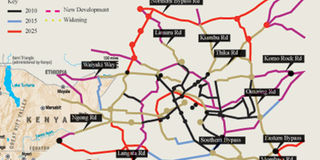New roads, railway proposed in bold plan to rebuild city

New roads will be built to connect various parts of Nairobi while old ones will be expanded in an ambitious plan to transform it into a modern and attractive city. GRAPHIC/NATION
What you need to know:
- The central business district will be linked to adjoining areas by road and rail under the urban transport component.
- Other developments under the urban transport component include a flyover to link the CBD to the proposed railway city, construction of the northern part of circumferential road connecting Mbagathi and Kilimani areas and development of new bus and matatus termini in the railway city.
New roads will be built to connect various parts of Nairobi while old ones will be expanded in an ambitious plan to transform it into a modern and attractive city.
The plan, which was launched yesterday, also proposes to demolish old estates in the Eastlands suburbs to pave way for highrise buildings where city residents can work and live.
It also proposes to revamp railway transport to ease the movement of people into and out of the city in a move that will reduce reliance on matatus and private vehicles.
Under the plan Governor Evans Kidero launched yesterday, a special lane will be set aside for buses in the bold plan to change public transport, one of the biggest challenges facing the city that is also the national capital.
It is expected that vast tracts of land owned by the Kenya Railways will be used to build a railway city while electricity way-leaves will provide additional land for infrastructure development.
The central business district will be linked to adjoining areas by road and rail under the urban transport component. Already, contracts for expanding Outer Ring and Enterprise roads have already been awarded. The roads are expected to include an extra lane for use by smart buses under the rapid transit system.
RAILWAY CITY
Other developments under the urban transport component include a flyover to link the CBD to the proposed railway city, construction of the northern part of circumferential road connecting Mbagathi and Kilimani areas and development of new bus and matatus termini in the railway city.
The plan would also see the expansion and improvement of the existing water and electricity supply while also addressing the challenges posed by pollution and waste management.
On water, the plan is to ensure neighbouring counties like Kiambu increase supply to the city by 800,000 cubic metres by 2030.
Mr Tom Odongo, the executive member in charge of Land, Housing and Physical Planning, yesterday said all sectors in the city must anchor their development plans on the masterplan otherwise they will experience difficulties in securing funding from the county government.
The draft plan has been forwarded to the National Environment Management Agency (Nema) for approval while the County Assembly is expected to debate and approve it by July.
Details on sectoral developments will be worked out before the masterplan can be implemented.
At this stage, the county government will be able to indicate how much it will cost to implement the masterplan that was developed with the assistance of Japan International Cooperation Agency (Jica).
REGIONAL HUB
A senior Jica representative, Mr Koji Noda, said some of the problems facing the city resulted from lack of a masterplan.
The Japanese agency will second an expert to the county planning department to assist in the implementation of the masterplan.
“Nairobi is both a capital city of Kenya and a logistics hub in the region. Making it attractive through implementing an integrated masterplan would attract investment and improve the city’s competitiveness,” Mr Noda said.
Dr Kidero committed to ensure the masterplan is implemented and that legislative and institutional requirements are met.
A planning officer from the county government, Ms Rose Muema, said the team that drafted the masterplan held 23 consultative meetings in sub-counties and also consulted the four counties which border Nairobi. A further 64 meetings were conducted in wards including focus group meetings.
The team also organised drawing and essay writing competitions that involved 320 pupils in the county.
The last masterplan for the city developed in 1973 was not fully implemented.
THE NUMBERS
Population set to hit 5.2m by 2030
3.1 million: The population of Nairobi in 2009. This grew to 3.6 million last year and is projected to hit 4.6 million in 2023 and 5.2 million by 2030.
354,221: Amount, of water, in cubic metres that city residents consumed in their homes in 2009. This rose to 399,750 last year and is project to hit 533,255 by 2023 and 599,437 by 2030.
69,044: Amount of water, in cubic metres used by industries in 2009. This reached 79,229 last year and will hit 119,888 in 2030.





